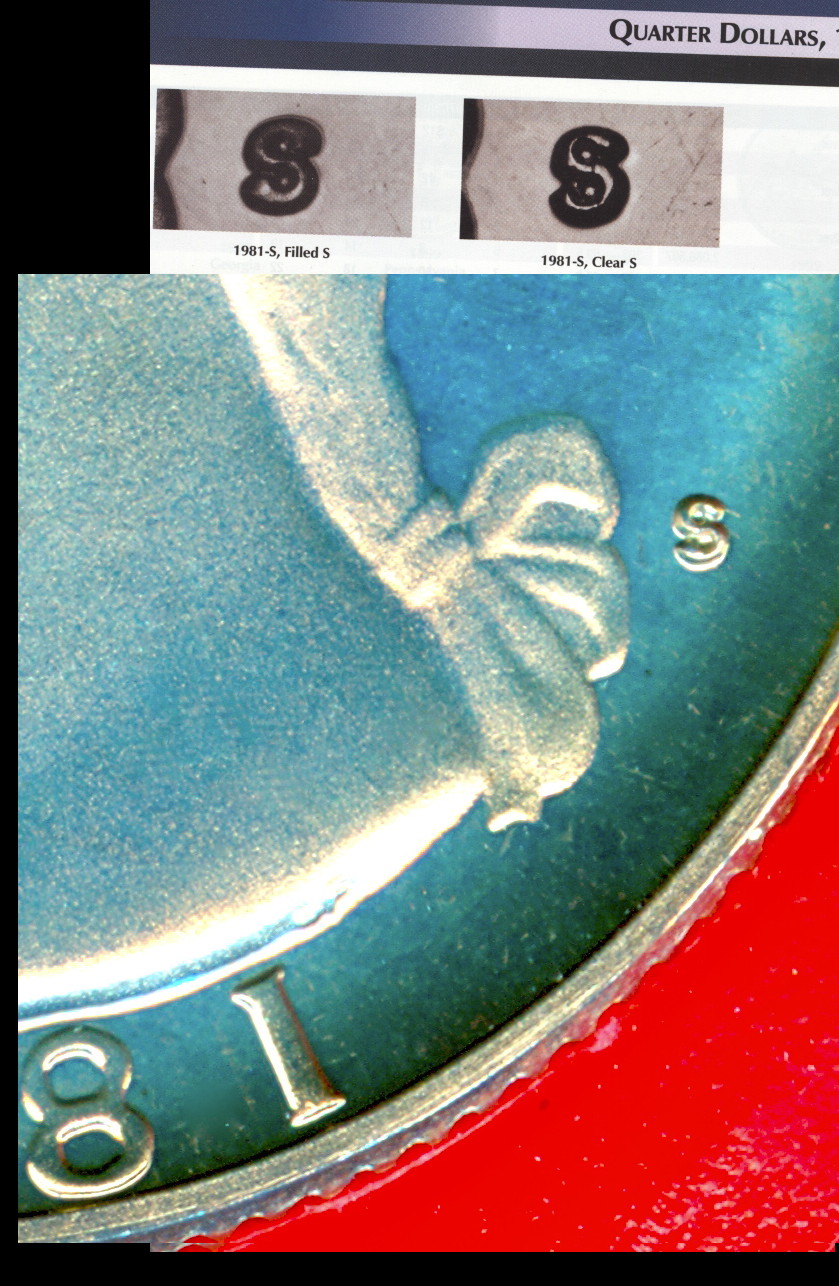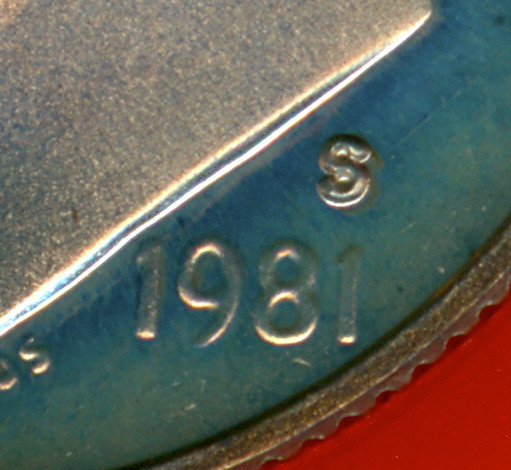A Further Analysis of the 1981-S Type 2 Proof Sets
Introduction
In 1981, the U S. Mint sold proof sets of the six coins issued that year (as they do every year) to the general public. However, in that year (similar to what happened two years earlier in 1979), the Mint made proof sets of two types, referred to as Type 1 and Type 2. All proof sets are made at the San Francisco Mint and as a result have an "S" mint mark on all six coins. The difference between Type 1 and Type 2 stems from differences in the actual "S" mint mark on the coins. Type 1 sets have a less clear "S" while Type 2 sets have a more clear "S". Type 2 sets were made and distributed late in the year 1981 and are worth considerably more.
Clearly it matters a great deal on whether a set is Type 1 or Type 2.
Therefore the following analysis is warranted.
The differences
Before looking at the pictorial evidence, an important fact is that this set came from a box of five sets (of which I was the original purchaser back in 1981) that was postmarked as received on December 30, 1981-- very late in the year. And while the Mint has never released what date in 1981 they began shipping the Type 2 sets, it was the latter part of the year. Any set received December 30 is virtually guaranteed to be Type 2; there was only one more delivery day left in 1981 after that. A photo of the original shipping box with the December 30, 1981 post mark is in the auction.
Pictorial Evidence
A picture is worth a thousand words. All the pictures below (the more colorful ones) are from the set that is currently for sale on ebay, compared where possible with official photos from the Red Book. Any person whether they are a coin collector or not can look at an official picture from a recognized coin guide such as the Red Book and determine for themselves whether the pictures of my coins match which of the two pictures of Type 1 versus Type 2 coins in the book. Let's examine the coins. The proof set consists of six coins: the cent, nickel, dime, half dollar and Susan B. Anthony dollar coin.
Of the six coins, the two most important ones are the penny and (even more so,) the dollar coin. Indeed it is the Type 2 dollar that gives the Type 2 set most of its value. The 2011 Red Book lists no distinction in values for the other four coins: nickel, dime, quarter and half dollar. Because of this, I want to focus on the two coins that "count": the penny and the dollar coin. I will talk briefly about the other coins at the end, but as you'll see, my point is made by looking at the penny and the dollar coin.
Penny
First the penny. Take a look at the following photo. In the upper, less colorful photos, you'll see the illustration between type 1 and type 2. These upper photos come from the 2010 Red Book Professional Edition, which is a somewhat more detailed guide than the "regular" edition of the Red Book. (The 2011 regular edition just came out in April 2010; the 2011 Professional Edition book will not be released until the fall; thus the 2010 Professional Edition is the most current.)

In the photo above look at the Red Book Type 2, clear S, on the upper right. It has a bigger width to height ratio than the type 1. Now look at the Red Book Type 1 on the upper left. The "holes" in the inside of the S's loops, both top and bottom, are very close to perfect circles and the also have almost no opening "to the outside world." Finally take a look at the two "surfaces" of the two Red Book S's. (The "surface" is the area on the top of the S such that if you were to turn the S over and lay it flat on a table, the "surface" would be the part that makes contact with the table). You'll notice that for the type 1, the "surface" is not as big as the overall S whereas the Type 2 the "surface" is virtually as big as the entire S. Finally, on the Type 2 S in the Red Book, the bottom curve of the S has a much wider arc-- i.e. the circle that it would make is bigger than the type 1. Relatedly, the top arc of the S in the Type 1, filled S, from the Red Book is a mirror image of the bottom arc. In the Type 2, the bottom arc is not a mirror image. Now take a look at my penny-- this is the original scan, in bright copper color at the bottom of the photo. You'll see that the "holes" in the S are far from perfect circles, especially the bottom hole. You'll also see that the there is some significant space for "water" in the hole inside the loop to leak out into the outside world as is characteristic of the Type 2 S. Notice that the surface of the S is essentially as big as the entire S and that the two arcs of the S are not mirror images of each other. The evidence is quite compelling that my penny is indeed a Type 2.
S.B.A. Dollar
Now let's turn our attention to the dollar. Take a look at the photo below. In that photo, I have the two Red Book photos at the top, my proof dollar from the set I am selling in the middle, and the very bottom photo shows my 1981-S dollar from my 1981 mint set (the mint set is not for sale.)

First, the descriptions for Type 1 versus Type 2 for the penny in the Red Book photos all apply to the dollar. But, here the analysis is easier because the mint made a dollar that year that we know for a fact is Type 1. That is the 1981-S dollar from the uncirculated set. Typically the U.S. Mint does not include "S" mint coins in the annual uncirculated sets, but because the S-mint dollar coin was supposed to be released into circulation, the mint included it in the 1981 mint set. All of the 1981-S dollar coins in the Mint Set were Type 1; the Type 2 coins existed only in the proof sets that year.
I've superimposed (outlined in white) the S from the proof dollar I am selling right next to the "S" on the uncirculated dollar. You'll notice that the two S's are clearly different. Since we know the uncirculated S is Type 1, the proof one is Type 2. There can be no other conclusion.
As a supplement to this discussion, take a look at this link from an expert who has studied the issue regarding the differences between the 1981 Type 1 and Type 2 dollar. It essentially echoes this analysis.
http://www.bakercoins.net/learn/articles/sba/sba.html
Half Dollar
After the S.B.A. Dollar coin and the Lincoln Cent, the third most important coin for the 1981-S Type 2 set is the half dollar. Indeed after the half, the Quarter, Nickel and Dime are the least important-- in that order. So I will keep my analysis brief for the half dollar and even briefer for the other coins.
Below is the official 2010 Red Book Professional Edition photos of the half, along with the half from the set I am selling.

Again, the same analysis applies. An asymmetric "S" when looked at along the X-axis-- the bottom curve has a much wider arc and the surface of the "S" is virtually as big as the entire S. Also, the holes in the loops of the "S" are not perfect circles as they are on the Type 1 "S".
Quarter, Nickel and Dime
Next, a brief analysis of the 1981-S Type 2 quarter. The Red Book does not list a distinction in values between the 1981-S Type 1 Quarter and the Type 2 Quarter. However, it does illustrate the differences, even though they're worth essentially the same. Here are the photos of the quarter. Once again, the official Red Book photos are at the top and the quarter from the set I am selling is at the bottom:

Again, some of the same characteristics of the other Type 2's-- a wider bottom arc, and the "holes" in the S having a noticeably larger opening to the "outside world" all apply.
For the nickel, not only does the Red Book not list a distinction in values, but it only publishes a picture of the Type 2 "S', not the Type 1 "S". Here's the photo:

A large opening to the "outside world" from the loops of the "S' is present and, like the other coins, the same can be said about the surface as well as the asymmetry of the top and bottom arcs.
Finally a brief discussion of the distinction between the 1981-S Type 1 and Type 2 dime is merited. The distinction discussion is merited as "brief" because I can find no photos of a 1981-S Type 1 or Type 2 dime either in the Red Book or any other coin guide for sale at Borders or Barnes & Noble. There may not even be a distinction between a Type 1 and a Type 2 dime from 1981-- no source mentions it or illustrates it. Nonetheless, for the sake of completeness, here's a close up photo of the dime from the set I'm selling:
